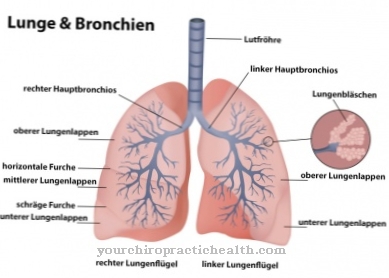The Lips represent an important organ of the human body, which takes on important tasks and functions in everyday life. At the same time, however, they can also be affected by diseases or indicate specific diseases by showing certain symptoms.
What are lips
Under the Lips, which in medical terminology also as Labium oris refers to the soft tissue folds found in the lower area of the face.
They are a paired organ that shields the oral cavity from the external environment and is characterized by great mobility. In addition, the lips, together with the cheeks, form the outer edge of the oral vestibule and fulfill some important functions in everyday life, which primarily include food intake or language formation.
The lips are not only found in humans, but also in mammals, in which they are often referred to as so-called lips and perform similar functions as in humans.
Anatomy & structure
The Lips are made up of an upper and a lower lip, which are above and below the opening of the mouth and are connected to one another at the corner of the mouth.
In addition, both the upper and lower lips are attached to the gums on the inside with a fold of the mucous membrane, which is also known as the lip frenulum. The upper edge of the upper lip has a curved groove in its center, which embodies the so-called Cupid's bow. Between this Cupid's bow and the nose there is also a depression, which is called the philtrum and can appear in various dimensions.
While the lips are covered on the inside with oral mucosa, on the outside they are surrounded by a thin skin consisting of three to five layers of cells. In addition, the orbicularis oris muscle that extends around the mouth is crucial for the basic shape and texture of the lips.
Other components of the facial muscles also lead to a high level of mobility. The arteria labialis inferior and arteria labialis superior, both of which originate from the facial artery, ensure that the lips are adequately supplied with blood.
Functions & tasks
The Lips fulfill some important functions and tasks in human everyday life. In the foreground is the support of food intake, in which the lips move the food or liquids in the oral cavity and to the teeth in cooperation with the cheek due to their great mobility.
In addition to the function of taking in food, the lips also play a major role in communication. They are an important component for correct language formation and contribute to the development of lip sounds (e.g. P, B, F and M). The lips can influence communication not only through language formation, but also through their special role in facial expressions.
Humans succeed in expressing their emotions correctly through the lip movements directed by the facial muscles. The lips can use targeted movements to ensure that, for example, anger, sadness or joy are correctly perceived by the conversation partner. In addition, there are numerous nerve endings in the lips through which a tactile function can be ascribed to them.
Illnesses & ailments
Since the Lips represent an organ of the human body, they can be affected by numerous diseases or show signs of certain diseases.
A very common disease is the so-called herpes labialis - simplified cold sores - which represents a form of herpes simplex infections and is noticeable through the formation of small, painful blisters on the lip.
While herpes simplex infections are usually harmless, they can lead to serious complications within certain risk groups. These people at risk include immune deficiencies such as HIV patients or newborns, but also people with chronic skin diseases such as neurodermatitis, in which the cold sore can spread over large areas of skin. Drying of the lips can often be found in both unconscious and healthy people.
Increased consumption of tobacco, exposure to strong sunlight, inadequate oral hygiene or tooth malformations can also lead to cancerous tumors on the lips. The upper lip in particular can be affected by diseases such as basalioma due to increased exposure to UV rays. In addition, the eversion of the lips enables a favorable view of the oral mucosa, which can indicate an existing anemia.






.jpg)






.jpg)

.jpg)
.jpg)











.jpg)